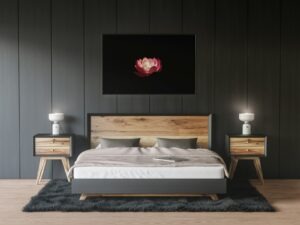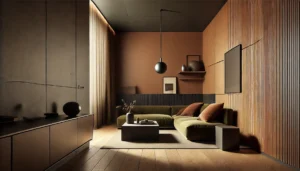Minimalist Interior Design: Essential Tips for a Serene and Functional Space
Introduction
Minimalist interior design follows the philosophy of “less is more,” focusing on simplicity, functionality, and intentionality. By eliminating excess and embracing clean lines, neutral palettes, and smart storage solutions, a minimalist home offers a sense of peace and openness.
Whether you’re looking to redesign your living room, bedroom, or entire home, these essential minimalist design tipswill help you achieve a modern, clutter-free space that feels both sophisticated and inviting.
Embrace Neutral and Subdued Color Palettes
 A minimalist home thrives on light and neutral colors, which enhance natural light and create a spacious ambiance.
A minimalist home thrives on light and neutral colors, which enhance natural light and create a spacious ambiance.
✔ Choose a neutral base – Whites, beiges, grays, and soft earth tones maintain simplicity and serenity.
✔ Add subtle contrast – Incorporate muted greens, soft browns, or terracotta for warmth without overpowering the space.
✔ Stick to a cohesive palette – Limiting colors ensures a harmonious and visually calming effect.
👉 Pro Tip: Use matte finishes and natural textures to add depth without cluttering the look.
Select Functional Furniture with Clean Lines
Minimalist furniture is all about simplicity, functionality, and clean geometry.
✔ Choose high-quality, multi-functional pieces – Each item should serve a purpose beyond aesthetics.
✔ Stick to simple silhouettes – Opt for sleek, straight lines and soft curves instead of ornate details.
✔ Invest in timeless designs – Avoid trends and focus on long-lasting, classic pieces.
👉 Furniture Rule: Less is more—prioritize essential pieces that enhance comfort and usability.
Maximize Natural Light for an Airy Feel
Natural light plays a crucial role in enhancing the openness of minimalist spaces.
✔ Use sheer curtains or blinds – Allows light to flow while providing privacy.
✔ Keep windows unobstructed – Avoid heavy drapes or excessive decor around windows.
✔ Utilize reflective surfaces – Light-colored walls, mirrors, and glass furniture help distribute light across the room.
👉 Lighting Hack: If natural light is limited, opt for warm LED lighting to mimic sunlight’s glow.
Incorporate Thoughtful Storage Solutions
A key principle of minimalist interior design is keeping spaces organized and clutter-free.
✔ Built-in cabinets and shelving – Offers seamless storage without disrupting the design flow.
✔ Hidden storage compartments – Use ottomans, beds, and benches with built-in storage.
✔ Minimalist wall hooks & organizers – Keep essentials accessible but neatly stored.
👉 Declutter Rule: If it doesn’t serve a purpose or spark joy, let it go.
Add Texture Through Natural Materials
Minimalism doesn’t mean sterile or boring—introducing textures from natural materials adds warmth and character.
✔ Wood elements – Warm oak, walnut, or ash wood for furniture, flooring, or accents.
✔ Stone surfaces – Marble, concrete, or limestone add sophistication and depth.
✔ Linen and cotton fabrics – Soft, breathable materials for curtains, cushions, and upholstery.
👉 Design Hack: Combine smooth and textured materials for visual interest without adding clutter.
Curate Minimalist Decor for Intentional Styling
Minimalist decor should be thoughtfully curated rather than excessive.
✔ Choose meaningful statement pieces – A single large artwork or a simple sculpture can act as a focal point.
✔ Use neutral-toned decor – Stick to ceramics, vases, or woven baskets in muted shades.
✔ Bring nature indoors – A single potted plant or a fresh bouquet can add life to the space.
👉 Decor Rule: Every item should serve a purpose or add value to the space.
Maintain Clear Surfaces & Open Spaces
To keep the space feeling airy and clutter-free, follow these key minimalist habits:
✔ Keep countertops, tables, and shelves mostly empty – Avoid unnecessary items.
✔ Use storage baskets or trays – Organize smaller objects neatly.
✔ Opt for floating furniture – Wall-mounted shelves and vanities help open up floor space.
👉 Organization Tip: Adopt the “one in, one out” rule—for every new item added, remove an old one.
Integrate Warm and Natural-Toned Lighting
Lighting should enhance the calm and cozy ambiance of a minimalist space.
✔ Use warm, soft lighting – Opt for bulbs with warm white or amber tones instead of harsh fluorescent light.
✔ Choose simple, elegant fixtures – Pendant lights, recessed lighting, or sleek floor lamps complement the aesthetic.
✔ Layer lighting sources – Combine overhead lights, task lighting, and ambient lamps for a balanced atmosphere.
👉 Pro Tip: Install dimmable lights to adjust brightness based on mood and time of day.
Creating a Minimalist Home That Feels Peaceful & Stylish
By applying minimalist interior design principles, you can create a home that is simple, functional, and aesthetically pleasing. A minimalist space is more than just a trend—it’s a lifestyle that promotes mindfulness, clarity, and relaxation.
Key Takeaways:
✔ Stick to neutral, earthy color palettes for a calming effect.
✔ Choose functional, well-crafted furniture with clean lines.
✔ Utilize natural light and smart storage solutions to maximize space.
✔ Incorporate natural materials and subtle textures for warmth.
✔ Keep decor minimal and intentional to maintain a clutter-free environment.
🚀 Ready to transform your home into a minimalist retreat? Start simplifying your space today!

Welcome to our home decoration blog, where we share inspiring home decor ideas for every room in your house. Discover new ways to add style and comfort to your home with our expert tips and tricks. Get inspired today with our home decor blog!




